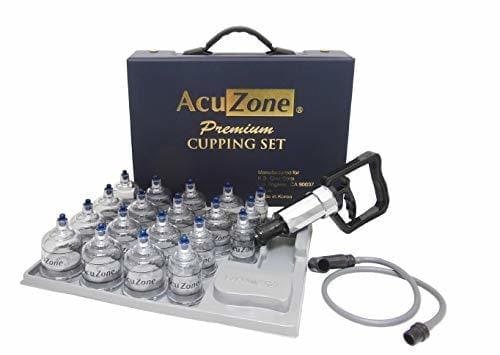Combat Arts Workout Recovery Cupping Therapy
Cupping therapy, or Fire cups, as they are also called, may seem like a relatively new idea, bursting onto the scene when a few famous martial artists like UFC fighter Khabib Nurmagomedov, Vitor “The Phenom” Belfort, and others claimed it helped them with pain, injury, and recovery. It is actually a very old form of medicine that came into use over 2,000 years ago..
Egyptian, Middle Eastern, and Chinese cultures have utilized this popular healing therapy for thousands of years, but worldwide acceptance has sent it around the globe. The original cups were made of animal horns, drained pus from wounds, and other uses, as recorded in A Handbook of Prescriptions for Emergencies, written by Eastern Jin Dynasty martial arts master, military officer, scholar, alchemist, and herbalist Ge Hong (283–343 AD).
“…seeing my husband suffering excruciating and chronic muscle pain and joint inflammations due to strenuous training in MMA…regular high-impact workouts are no easy task. They leave muscles stiff, restrict mobility and cause persistent aches in the back, shoulders, neck and lower body that can easily turn into a real detriment for passionate athletes…natural, efficient and an inexpensive…benefits of a traditional Cupping Therapy…”
Stella Rubinshteyn
Cupping Recovery Techniques
Cupping is a traditional Chinese medicine (TCM) recovery practice that involves placing cups full of heated air on the skin so that a vacuum and suction are created as the air cools. These cups are placed over acupuncture points, thereby drawing blood and energy into a certain prescribed area to increase blood flow, loosen tight fascia, and facilitate healing and recovery.
The cups used in cupping are typically made of glass, bamboo, silicone, or earthenware. There are different modalities for cupping which are used for different purposes and types of recovery treatments.
In China, 7 major types of cupping are typically used. These types include:
Martial Artists find Cupping Therapy Effective for Treating Pain
Pain for martial artists typically occurs through accident, injury, illness, or age. Pain is often the body’s way of posting a warning sign, like ‘don’t move your knee like that!’ The body uses pain to protect itself against further injury, warning against improper foot placement, wrong knee angles, overzealous bag work, over training, and exhaustion. All martial artists experience serious pain at some point in their practice.
% of Doctor visits related to acute pain
% of Doctor visits due to reoccurring pain
The efficiency of cupping therapy for reducing intensity of pain in chronic and acute issues has been proven to be significant. Research has shown that cupping therapy is more effective than heat for pain reduction, gives more relief than pharmaceutical drugs, and combines effectively with acupuncture to increase efficiency at pain management—which means more time training—less time recovering.
Learn the Principle of Balancing Your Body's Energy Through Cupping
Subscribe to Learn More!
Cupping Stops Spasms and Increases Blood Flow
Martial arts training and major events can leave you with spasming trapezius muscles, aching rhomboids, and super tight quads. Cupping appears to ease tightness, stop spasms, and relieve aching muscles. It greatly increases microcirculation in the network of tiny veins composed of capillaries, venules, and arterioles. This eases pain, aching, and tightness. Bruising or marks appear because cupping causes broken blood vessels beneath skin tissue, rather like a large ‘love bite'.
This network assists in regulating blood pressure, along with blood flow in and out of organs and tissues. They bring blood to the body’s tissues while transferring out inflammatory cells, excess heat, and solutes. Research into cupping shows increased blood and energy is focused upon acupoints and meridians, resulting in a release from pain and tension because of hemostasis or hyperemia.
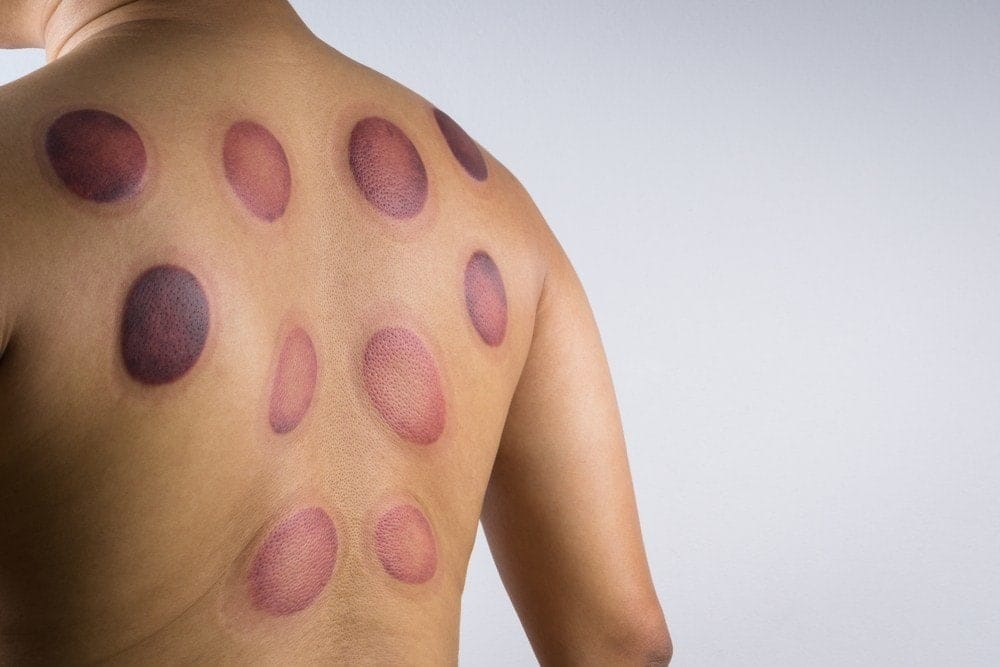
It helps rid the body of accumulated toxins, intensely oxygenizing the area of treatment, stimulating the nervous system, and jumpstarts healing. Cupping is still being researched, and the exact manner in which it works is still unclear, although many ways it achieves results have become clearly established. There are many physical issues that consistently show positive results and relief when cupping techniques are utilized, but like any healing modality, it does not work(link) for every person or for every issue[8].
Ancient Therapy Seen in a New Light
This recovery method kicks your pain to the curb! When modern science doesn’t understand how a therapy works, it tends to ‘poopoo’ its effectiveness. Cupping therapy has long been considered ‘folk’ medicine, and is a part of Traditional Chinese medicine (TCM), as are acupuncture and Qigong, all of which are now being viewed in a new light as modern scientific methods of testing and documentation finally catch up with ancient medical wisdom and science to prove definitively how these traditional methods achieve results.
Research results have proven that for powerful martial artists and other major athletes, cupping therapy quickly reduces pain, swelling, tightness, and spasms, and has proven to be more beneficial and efficacious that conventional drugs or care.
Cupping Therapy For Martial Artists
There is a reason why cupping was shown being used in the film, The Karate Kid. That is because the same principles applied in traditional Chinese medicine and cupping are used in martial arts such as tanglang, wushu, tai chi, and other traditional martial styles. Cupping uses principles such as balancing the bodies’ energies, meridians, or Qi, basic knowledge of anatomy and physiology in ways similar to traditional martial arts because they sprang from the same source.

Source: Instagram/ thenotoriousmma
Martial artists are super savvy about pain, injury, healing, and recovery because they have to be. Martial arts training and fight events can be grueling, and brutal on the body. All great and fun, but after the adrenaline drains, often there’s pain, spasms or injuries that didn’t even register while back in battle mode. Über tight muscles following events make it tough to relax back into training at optimal levels.
Many martial artists would love to get fast as Alex Huynh, three-time gold medalist in wushu, a style of kung fu, who at 12.2 meters a second strikes faster than a snake strikes at 2.5-3 meters a second. They want to wield a more powerful knee strike than Melchor Menor, former two-time Muay Thai world champion, whose knee strike to the chest delivers a force equal to a 35 mile-an-hour car crash. The truth about speed in martial arts, though, is the more relaxed the body, the faster and more powerful the delivery.
Many martial artists find their shoulders getting stiff or creeping up with extreme tension, knotted muscles spasming during or after training and events. Plus, add extreme martial arts training to long days working on the computer, or driving through heavy traffic, and the stress adds up to equal chronically spasming muscles and wickedly tight shoulders that don’t always respond to regular treatment.
That’s when martial arts masters and coaches use TCM treatment methods known as dit da, which is the traditional Chinese art of healing injuries, also known as fall and hit medicine. It is speciality medicine created to be used for pain, injury, and to optimize performance[10]. Or in MMA fight camp, for example, coaches use all repair methods available, including cupping, to help fighters’ bodies recover after killer training sessions[11].
Spasming muscles can diminish quality of life, much less speed and power when striking. This type of tight binding, knots, and spasms can even pull on vertebrae, cause headaches through tense neck muscles pulling on occipital areas, cause numbness or tingling, and referred pain to other parts of the body such as legs.
Cupping therapy has been shown to help relieve and release these types of areas. If these are older, chronic issues, more treatments will be required for healing, loosening, and maintaining relaxed muscles. Releasing these types of painfully tight areas will improve martial arts techniques.
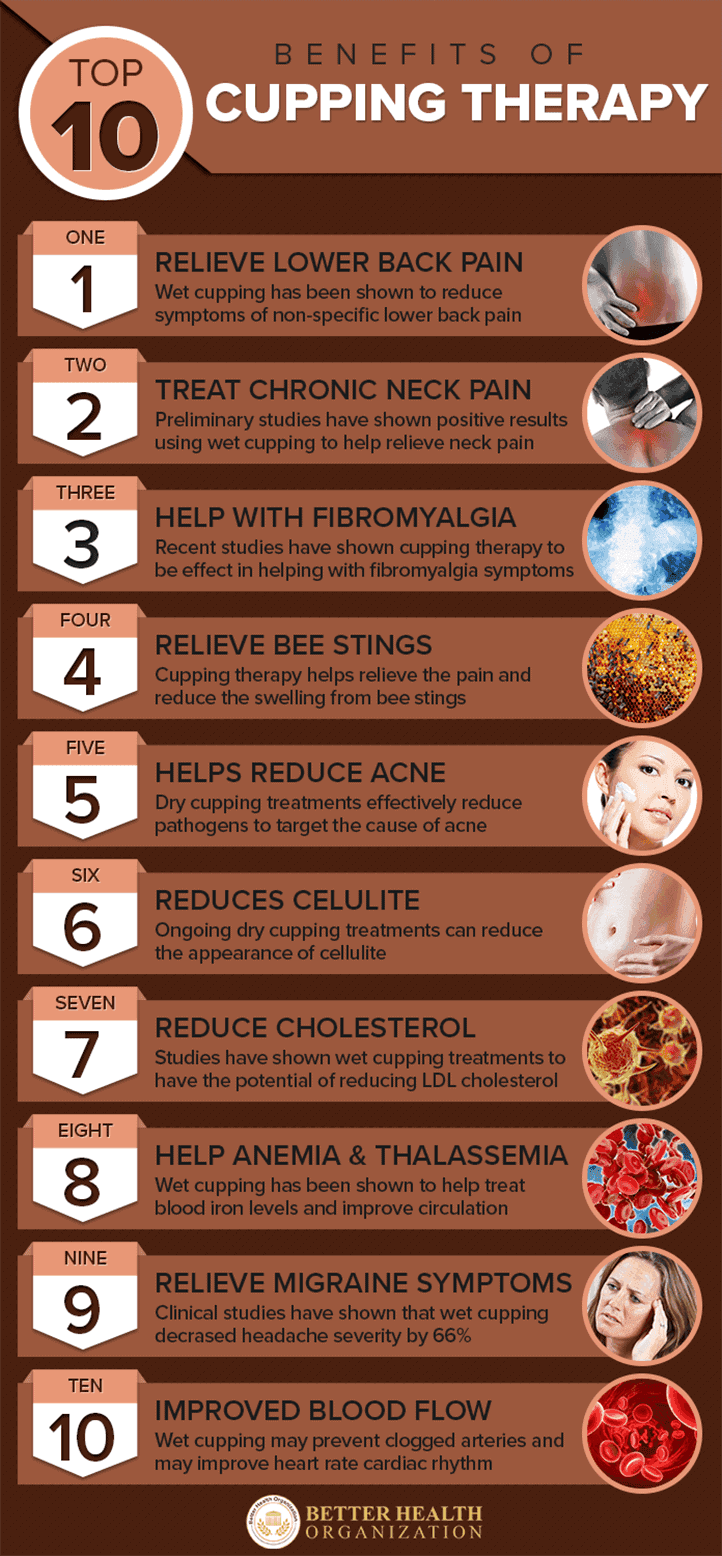
When the shoulders are down and in a relaxed position, it allows for a faster, more powerful technique. Cupping was recently described as a treatment that can strengthen the body’s resistance, restore balance between positive and negative forces, remove disease-causing factors, and promote blood circulation.
Many conditions can be treated with cupping therapy: neck and shoulder pain, abdominal pain, back pain, numbness of the limbs, and other acute or chronic pains such as rheumatic pain, menstrual pain and headache, among others. ~ Dr. Lin Zhi-xiu
Cupping Therapy Affects the Nervous System
One clear answer to exactly what cupping therapy does to relieve pain and help heal physical, mental, and emotional issues is that it stimulates the sensory nerves of the skin. That creates an inhibitory effect on hypersensitive pain which is not limited to the area of direct treatment, but also connects with areas controlled by relevant nerves. Treatment given on the back will thus stimulate spinal nerves, and parasympathetic nerves as signals travel down the central line, affecting sympathetic nerves, and stimulating the meridians.
Stimulation of this area positively affects the autonomic nervous system, along with connected organs. Cupping therapy helps reduce or release anxiety, worry, and symptoms caused by excessive stress. It protects against chronic diseases such as high blood pressure, neuralgia, and rheumatism. Cupping techniques are comfortable and relaxing while they stimulate the nervous system, and reduce stress during and after treatments. It has become extremely clear that many of the healing benefits and results of cupping treatments are because all cupping techniques affect and influence the nervous system.
What To Expect When Cupping
The cups are small, hollow and typically very light, made of glass, bamboo, silicone, or earthenware. The martial artist typically lies down or sits while the practitioner creates suction inside the cup by using heat, like a lit match, flaming piece of paper, or mechanical devices, such as hand or electrical pumps. The cup is applied to the affected area, whether dry, with oil, or other methods, and as the air inside the cup cools.
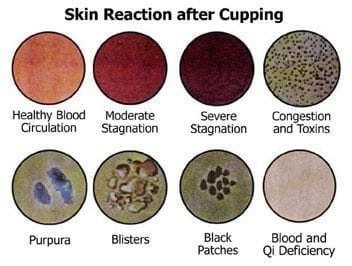
It creates suction inside the cup on that area of skin which may feel intense, but usually feels relaxing and not uncomfortable. The air inside the cup cools, creating a vacuum that pulls the tissue, and draws it up into the cup. This increases the blood flow, loosens the fascia or connective tissue, and stimulates healing functions in the body. Blood vessels expand, causing skin to rise and redden inside the cup.
Cupping works in a similar way to how deep tissue massage can break up scar tissue, loosen painfully knotted fascia, and alleviate pain. Temporary bruising or reddening of skin is considered proof positive that the treatment has successfully removed toxins and stagnation. MMA fighters have been using it for injury, training, and event recovery with excellent results.
The popularity of cupping has skyrocketed because martial artists, pro fighters, and other top athletes swear by it, claiming it reduces back pain, shoulder pain, spasms, releases tightness and knots in muscles, etc..
Cupping Works For Many Issues
Cupping therapy has had a few thousand years of usage, development, testing, and improvement before arriving at its current highly efficient state. Primarily Gong Fu masters created fall and hit medicine, and had uncounted opportunities to test its efficaciousness on innumerable physical, mental, and emotional issues to test usefulness[16].
Cupping Therapy Forces Muscles To Relax
It works on reducing many Fibromyalgia symptoms, such as pain, weakness, fatigue, and areas of tenderness[17]. This procedure has been used successfully on back pain, arthritis, injuries, sciatica, asthma, fatigue, anemia, headaches, infertility, blood pressure, atrophy, skin problems, constipation, diarrhea, menstruation issues for women, depression, cellulite, and emotional issues.
Cupping also has beauty applications such as weight loss, skin improvement, has been used for lowering cholesterol, and improving immune function. Sliding cupping has been used on the face to visibly reduce the appearance of fine lines and wrinkles, lift, tone and sculpt the face, stimulate collagen, clear toxins by stimulating lymphatic drainage, relieve TMJ, tooth pain, and facial tension.
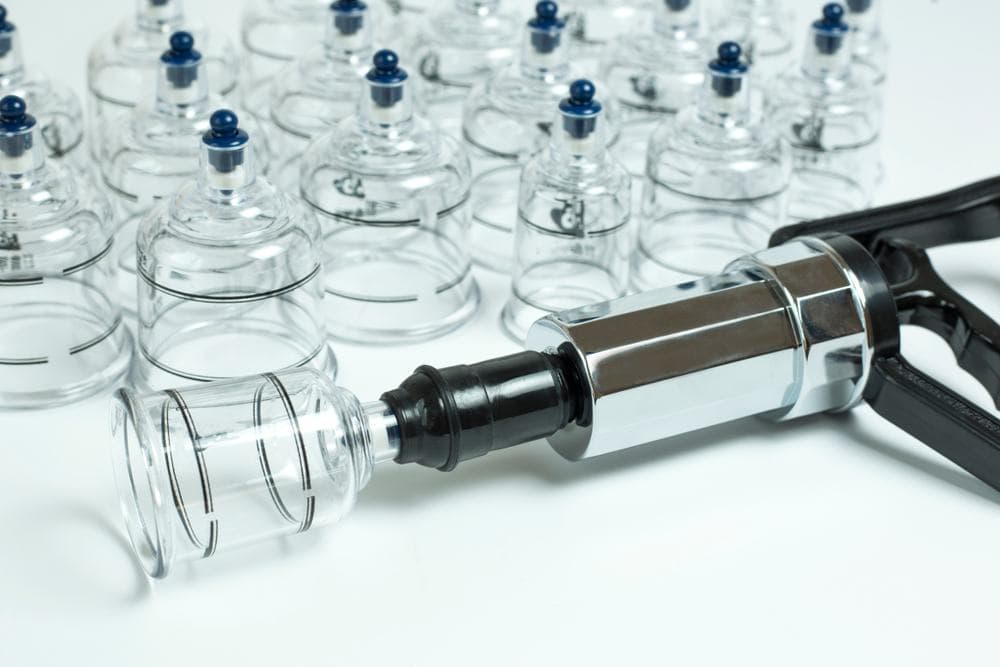
Cupping aids many diseases, but also has been proven to prevent them, if used in a correct and timely manner.
Martial artists use cupping techniques or Fire cupping because it forces the muscles to relax, pulling and stretching the fascia, and exhausting the muscle until it releases. Deep massage techniques can also exhaust and relax the muscles in a similar manner, but that typically requires a very long time to accomplish.
Those who have tried both deep massage and cupping techniques report that cupping achieves deep muscle relaxation in only a few minutes, whereas similar results using massage typically require an hour or more.
Part of that difference is undoubtedly the fact that cupping applies a continuous force that stretches and pulls on muscles. This stretching force is applied continuously, thereby disconnecting the muscle ‘rebound’ effect, and not allowing muscles to ‘snap back’ and re-tighten.
Heat can relax muscles, but will not usually stop or inhibit spasms in the muscle, so tightness will return as muscles cool down.
Cupping techniques, however, stretch out the skin, fascia, and muscle continuously, allowing them to pull against the action of the cup, until they finally tire out and simply relax. Once relaxation occurs, deep, extreme stretching takes place within the tissue, limited only by elasticity of the skin.
Massage may be applied to the muscles at this point of deep relaxation, and will have a more profound effect. Dit Da Jow, Tiger balm. Battle Balm, Hemp CBD oil, or other healing Amazon Links. ointment may be applied at this point to help the muscles recover after treatment. Cupping technique is repeated often as necessary over days or weeks to get muscles unknotted, unkinked, and fully relaxed.
Cupping Therapy Is A Safe Treatment
Cupping therapy is extremely safe, non-invasive, and has no side effects. That said, it must be performed carefully, and correctly by a trained therapist in order to achieve optimal results. There are many kung fu masters, acupuncturists, massage therapists and other healers who have completed the necessary training.
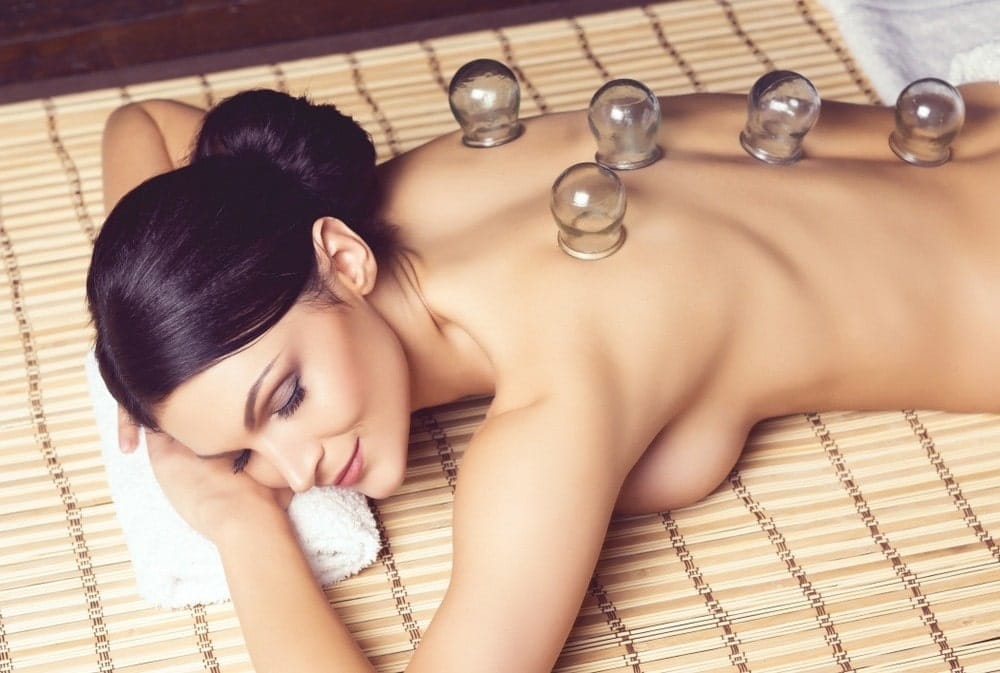
Primary concerns are efficiency of treatment, overly bruising the skin, and possible burns. Treatment will leave temporary circular discolorations that fade typically in days or occasionally in weeks, and side effects are generally no more that a slight pinching during treatment. Treatment by a trained practitioner will provide safe, economical, treatment for many issues.
Cupping Effective When Combined With Other Treatments
Cupping therapy combines well with other treatments, such as acupuncture, massage, and medications. Combined treatment showed increased benefit over other single treatments alone in effectiveness for herpes zoster, acne, facial paralysis, and cervical spondylosis. It is common practice in China to combine TCM treatments with Western medicine, when needed, to enhance efficiency.
Doing Cupping Therapy at Home for Pain Control, Recovery, Injury, And/Or Beauty
Martial artists dealing with pain, spasms, or extremely tight muscles may want to use it at home. There is much evidence that cupping relieves pain, injuries, and quickens recovery. Cupping also helps with other issues, as increasing circulation and oxygen to an area is always beneficial. This healing modality is said to be a natural face lift, reduce wrinkles and fine lines, and smooth out tension from the face, neck and chest.
It is recommended for DIY by some, and not by others, but bears investigation to ascertain for oneself. It is a safe and easy to learn technique, even for the non professional. Cupping is considered generally safe for healthy people when performed by a trained health professional; however, bruising, soreness, burns, discomfort, and skin infections are possible.
Therefore, extra caution is advised when practicing this technique at home. The recommendation is to get a professional to teach you how to do the technique correctly and safely. There are some safety rules of thumb. To avoid burns, many practitioners and DIY users invest in modern fire cupping sets that use a pump rather than fire to create the vacuum.
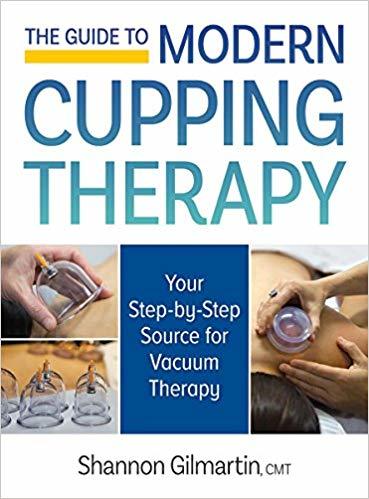
Do not use cupping over damaged skin or open wounds. Do not repeat cupping on an area until the circles, or bruises from a previous treatment have healed. See cautions before attempting treatment.
Do It Yourself Cupping for Home Use
Cupping therapy should only be performed after training from a professional. There are also tutorials available, though personal teaching is always preferable. Basic use on muscles, back, thighs, and other areas is similar, although care should be used on thinner skinned areas, such as chest, neck, groin, inner thigh, and face.
These areas will be treated with similar applications as for the face. Basic facial protocol requires use of an oil, since skin should never be pulled, and this keeps the cup moving at all times.
Cupping therapy should only be performed after training from a professional. There are also tutorials available, though personal teaching is always preferable. Basic use on muscles, back, thighs, and other areas is similar, although care should be used on thinner skinned areas, such as chest, neck, groin, inner thigh, and face.
These areas will be treated with similar applications as for the face. Basic facial protocol requires use of an oil, since skin should never be pulled, and this keeps the cup moving at all times.
A gentle gliding action is involved to increase blood circulation. Flash cupping can also be used, which involves allowing suction to occur, then immediately removing cup.
Never leave the cup standing still on the delicate skin of the inner thigh, face, neck, or chest. It should never stand static in one position to avoid broken capillaries or undesired redness. Always anchor skin with the other hand while gently massaging area. There are several companies that have designed specialty cupping kits, for use on nearly any part of the body.
They have cupping sets for relieving muscle spasms and joint pain, increasing mobility, shortening recovery time, increasing circulation, helping with sinus, colds, and cough. Plus they have cosmetic kits for use on face, eyes and lips, toning and shaping the body, and reducing cellulite. Lure Essentials is one that appears to be excellently researched, gives fast results, reasonably priced, and has tutorials, along with directions[24] [25].
Cautions When Cupping
Mild adverse effects from cupping may include hematoma and pain at the treated site, increasing local pain or tingling. Dr. Lin Zhi-xiu, a registered Chinese medicine practitioner and acting director of the School of Chinese Medicine at the Chinese University of Hong Kong (CUHK).
Dr. Lin Zhi-xiu
Cupping is usually very safe, especially under the care of qualified TCM practitioners.Two health dangers are skin burns due to dripping alcohol, and skin blisters due to excessively tight cupping and the cup being left on the body for too long.
Contraindications When Cupping
It is important to follow safety guidelines with any kind of treatment. Be very cautious treating anyone who has diabetes, is elderly or has very thin skin. Cupping should not be performed on people with underlying health conditions, as more serious side effects can occur. Cupping should not replace necessary conventional treatment.
It’s very rare for cupping to cause serious problems, though skin infections, anemia, and skin pigmentation, have been reported. Treatment is not advised on pregnant women (unless great care is taken), those who suffer from heart conditions, blood clots, cancer, are on blood thinners, diabetes, have varicose veins, or certain other medical conditions.
Cupping Therapy Requires More Research
There are many studies with convincing evidence of effectiveness, but not as clear of an understanding of how this treatment functions with the body to achieve positive results. Cupping has been utilized and studied for thousands of years as a healing modality for pain, injury, and other issues.
Learn More About the Recovery Trend That Has Been Around for Centuries!
Our Newsletter Shares Great Recovery Tips!
Many years of successful treatments in TCM has provided plentiful testimony as to its effectiveness as a healing treatment. It is easy to use, helps reduce pain and quickens recovery of many injuries and issues, safe, reasonably priced, with the primary drawback only a temporary skin discoloration.
Research results have shown that cupping gives many benefits to martial artists that are difficult to find elsewhere, including extremely quick pain, spasm, and injury relief, deep tissue relaxation, and increased immune system function.
Cupping therapy has proven useful in many types of pain control and improvement of quality of life, is non-invasive, reasonably priced, has minimal risks or side effects, and is very safe when treatment is performed by a professionally trained practitioner. It also has proven useful for DYI treatments, if proper instructions and cautions are followed.

